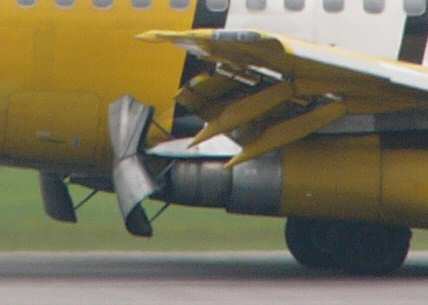Reverse Thrust
he original 737-1/200 thrust reversers were pneumatically powered clamshell doors taken straight from the 727 (shown left). When reverse was selected, 13th stage bleed air was ported to a pneumatic actuator that rotated the deflector doors and clamshell doors into position. Unfortunately they were relatively ineffective and apparently tended to push the aircraft up off the runway when deployed. This reduced the downforce on the main wheels thereby reducing the effectiveness of the wheel brakes.By 1969 these had been changed by Boeing and Rohr to the much more successful hydraulically powered target type thrust reversers (shown right). This required a 48 inch extension to the tailpipe to accommodate the two cylindrical deflector doors which were mounted on a four bar linkage system and associated hydraulics. The doors are set 35 degrees away from the vertical to allow the exhaust to be deflected inboard and over the wings and outboard and under the wings. This ensures that exhaust and debris is not blown into the wheel-well, nor is it blown directly downwards which would lift the weight off the wheels or be re-ingested. Fortunately the new longer nacelle improved cruise performance by improving internal airflow within the engine and also reduced cruise drag. These thrust reversers are locked against inadvertent deployment by both deflector door locks and the four bar linkage being overcenter. To illustrate how poor the original clamshell system was, Boeings own data says target type thrust reversers at 1.5 EPR are twice as effective as clamshells at full thrust!
The CFM56 uses blocker doors and cascade vanes to direct fan air forwards. Net reverse thrust is defined as: fan reverser air, minus forward thrust from engine core, plus form drag from the blocker door. As this is significantly greater at higher thrust, reverse thrust should be used immediately after landing or RTO and, if conditions allow, should be reduced to idle by 60kts to avoid debris ingestion damage. Caution: It is possible to deploy reverse thrust when either Rad Alt is below 10ft – this is not recommended
The REVERSER light shows either control valve or sleeve position disagreement or that the auto-restow circuit is activated. This light will illuminate every time the reverser is commanded to stow, but extinguishes after the stow has completed, and will only bring up master caution ENG if a malfunction has occurred. Recycling the reverse thrust will often clear the fault. If this occurs in-flight, reverse thrust will be available after landing.
The REVERSER UNLOCKED light (EIS panel) is potentially much more serious and will illuminate in-flight if a sleeve has mechanically unlocked. Follow the QRH drill, but only multiple failures will allow the engine to go into reverse thrust.
The 737-1/200 thrust reverser panel has a LOW PRESSURE light which refers to the reverser accumulator pressure when insufficient pressure is available to deploy the reversers. The blue caption between the switches is ISOLATION VALVE and illuminates when the three conditions for reverse thrust are satisfied: Engine running, Aircraft on ground & Fire switches in normal position. The guarded NORMAL / OVERRIDE switches to enable the reverse thrust to be selected on the ground with the engines stopped (for maintenance purposes).
Huskit
The first "hushkit" was not visible externally, in 1982 exhaust mixers were made available for the JT8D-15, -17 or -17R. These were fitted behind the LP turbine to mix the hot gas core airflow with the cooler bypassed fan air. This increased mixing reduced noise levels by up to 3.6 EPNdB.
Several different Stage III hushkits have been available from manufacturers Nordam (shown right) and AvAero since 1992. The Nordam comes in HGW and LGW versions.
As hushkits use more fuel, the EU tried to ban all hushkitted aircraft flying into the EU from April 2002. This was strongly opposed and the directive has been changed to allow hushkitted aircraft to use airports which will accept them.
737 classics may be fitted with hardwall forward acoustic panels which reduce noise by 1 EPNdB





Are you going to do a follow up article? Would love to know what happens next.
ReplyDeleteAmela
pneumatic actuator